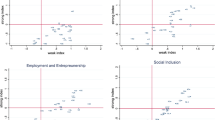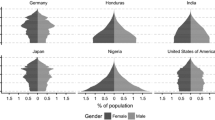Abstract
This paper develops an empirical methodology for the construction of a synthetic multi-dimensional cross-country comparison of the performance of governments around the world in improving the livelihood of their younger population. The devised ‘Youth Welfare Index’ is based on the nonparametric Data Envelopment Analysis (DEA) methodology and allows for cross-country benchmarking and comparison over time. The value added of the youth index is to produce country-specific rankings and trace performance evolution with respect to indicators solely centered on youth, unlike other development indicators like the Human Development Index (HDI) which bundles many social and development indicators.

Similar content being viewed by others
Notes
See Atkinson et al. (2004) for an extensive discussion of the EU’s social inclusion indicators.
References
Atkinson, A. B. (2003). Multidimensional deprivation: Contrasting social welfare and counting approaches. The Journal of Economic Inequality, 1, 51–65. doi:10.1023/A:1023903525276.
Atkinson, A. B., Marlier, E., & Nolan, B. (2004). Indicators and targets for social inclusion in the EU. Journal of Common Market Studies, 42(1), 47–75. doi:10.1111/j.0021-9886.2004.00476.x.
Caves, D. W., Christensen, L. R., & Diewert, W. (1982). The economic theory of index numbers and the measurement of input. Output and productivity. Econometrica, 50, 1393–1414. doi:10.2307/1913388.
Cherchye, L., & Kuosmanen, T. (2004). Benchmarking sustainable development: A synthetic meta-index approach. In M. McGillivray (Ed.), Perspectives on inequality, poverty and human well-being. Tokyo: United Nations University Press.
Cherchye, L., Moesen, W., & Van Puyenbroeck, T. (2004). Legitimately diverse, yet comparable: Synthesizing social inclusion performance in the EU. Journal of Common Market Studies, 42(5), 919–955. doi:10.1111/j.0021-9886.2004.00535.x.
Färe, R., & Grosskopf, S. (2000). Reference guide to On Front, EMQ. www.emq.com.
Färe, R., Grosskopf, S., & Lovell, C. K. (1994). Production frontiers. Cambridge: Cambridge University Press.
Zaim, O., Fare, R., & Grosskopf, S. (2001). An economic approach to achievement and improvement indexes. Social Indicators Research, 56, 91–118. doi:10.1023/A:1011837827659.
Author information
Authors and Affiliations
Corresponding author
Rights and permissions
About this article
Cite this article
Chaaban, J.M. Measuring Youth Development: A Nonparametric Cross-Country ‘Youth Welfare Index’. Soc Indic Res 93, 351–358 (2009). https://doi.org/10.1007/s11205-008-9328-2
Received:
Accepted:
Published:
Issue Date:
DOI: https://doi.org/10.1007/s11205-008-9328-2




